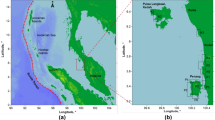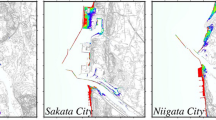Abstract
Tsunamis can cause massive damage and loss of life in coastal areas. This study uses Putuoshan Island as a case study to discuss ways to identify tsunami prevention zones based on the analysis of physical factors such as inundation, maximum wave amplitude, and tsunami flow. In the Ryukyu Trench Mw 9.0 tsunami scenario, the tsunami prevention zones of Putuoshan Island consist of land areas and marine areas. Our analysis identified two inundation areas in the western and southern Putuoshan Island as tsunami prevention zones. With the exception of the western marine area, the coastal waters of Putuoshan Island are also identified as tsunami prevention zones. The tsunami flow impact is greater in the waters of north and south Putuoshan Island. The results of this study could be used by emergency departments to take protective measures and thus to prevent the disastrous effects of tsunamis.











Similar content being viewed by others
References
Allan J, Komar P, Witter R (2012) The March 2011 Tohoku tsunami and its impacts along the U.S. west coast. J Coastal Res 28(5):1142–1153
Attary N, Unnikrishnan V, van de Lindt J, Cox D, Barbosa A (2017) Performance-based tsunami engineering methodology for risk assessment of structures. Eng Struct 141:676–686
Dunbar P, Mccullough H, Mungov G, Varner J, Stroker K (2011) 2011 Tohoku earthquake and tsunami data available from the national oceanic and atmospheric administration/national geophysical data center. Geomat Nat Haz Risk 2(4):305–323
Exton M, Harry S, Kutter B, Mason HB, Yeh H (2019) Simulating Tsunami inundation and soil response in a large centrifuge. Sci Rep 9(1):1–12
Guidelines for design of structures for vertical evacuation from tsunamis, FEMA P-646, Second edition, applied technology council for the federal emergency management Agency, Washington, D.C.
Guidelines for design of structures for vertical evacuation from tsunamis, FEMA P-646, Third edition, applied technology council for the federal emergency management agency, Washington, D.C.
Fiedler J, Mcmanus M, Tomlinson M, De Carlo E, Pawlak G, Steward G, Nigro O, Timmerman R, Drupp P, Ostrander CE (2014) Real-time observations of the February 2010 Chile and March 2011 Japan tsunamis recorded in Honolulu by the pacific islands ocean observing system. Oceanography 27(2):186–200
Fritz H, Phillips D, Okayasu A, Shimozono T, Liu H, Mohammed F, Skanavis V, Synolakis C, Takahashi T (2012) The 2011 Japan tsunami current velocity measurements from survivor videos at Kesennuma Bay using LiDAR. Geophys Res Letters 39(L00G23):L00G23-L00G28
Gao J, Ma X, Dong G, Chen H, Liu Q, Zang J (2021) Investigation on the effects of Bragg reflection on harbor oscillations. Coast Eng 170:103977
Hayes G, Wald D, Johnson R (2012) Slab1.0: A three-dimensional model of global subduction zone geometries. J Geophys Res 117:B01302
Heidarzadeh M, Satake K (2014) Possible sources of the tsunami observed in the northwestern Indian Ocean following the 2013 September 24 Mw 7.7 Pakistan inland earthquake. Geophys J Int 199(2):752–766
Hou J, Li X, Yuan Y, Wang P (2016) Tsunami hazard assessment along the Chinese mainland coast from earthquakes in the Taiwan region. Nat Hazards 81(2):1269–1281
Hou J, Li X, Wang P, Wang J, Ren Z (2020) Hazard analysis of tsunami disaster on the Maritime Silk Road. Acta Oceanol Sin 39(1):74–82
Li L, Switzer A, Wang Y, Chan C, Qiu Q, Weiss R (2018) A modest 0.5-m rise in sea level will double the tsunami hazard in Macau. Sci Adv 4(8):eaat1180
Mori N, Takahashi T, Yasuda T, Yanagisawa H (2011) Survey of the 2011 Tohoku earthquake tsunami inundation and run-up. Geophys Res Lett 38:L00G14
Mutsuda H, Fujii S, Ardianti A, Doi Y, (2015). Numerical simulation of tsunami force acting on a floating/submerged tsunami shelter. In: COUPLED PROBLEMS 2015—Proceedings of the 6th International Conference on Coupled Problems in Science and Engineering. 1171–1184
NGDC, 2006. 2-minute gridded global relief data (ETOPO2) v2. National geophysical data center, NOAA. Doi: https://doi.org/10.7289/V5J1012Q [access date: 2020]
Nistor I, Palermo D, Cornett A, Al-Faesly T (2011) Experimental and numerical modeling of tsunami loading on structures. Coast Eng Proc 1(32):2
Ren Z, Hou J, Wang P, Wang Y (2021) Tsunami resonance and standing waves in Hangzhou Bay. Phys Fluids 33(8):081702
Ren Z, Gao Y, Ji X, Hou J (2022) Deterministic tsunami hazard assessment and zoning approach using far-field and near-field sources: Study of Cixi County of Zhejiang Province. China Ocean Eng 247:110487
Tozer B, Sandwell D, Smith W, Olson C, Beale J, Wessel P (2019) Global bathymetry and topography at 15 arc seconds: SRTM15+. Accept Earth Space Sci 6(10):1847–1864
UNESCO/IOC, 2011. Exercise Pacific wave 11. A Pacific-wide tsunami warning and communication exercise, 9–10 November 2011. Volume 1. IOC Technical Series No 97
UNISDR, 2015. Making development sustainable: the future of disaster risk management. Global assessment report on disaster risk reduction. Geneva, Switzerland: United Nations Office for Disaster Risk Reduction (UNISDR)
Wang X, Liu P (2006) An analysis of 2004 Sumatra earthquake fault plane mechanisms and Indian Ocean tsunami. J Hydraul Res 44(2):147–154
Wang P, Shan D, Wang G, Yu F, Hou J, Zhao L, Yuan Y, Fan T, Ren Z, Wang Z (2016) Modelling and assessment of tsunami-induced vortex flows hazards from the 2011 MW9.0 Tohoku–oki earthquake in harbors and adjacent area. Chin J Geophys 59(11):4162–4177
Wang Y, Zamora N, Quiroz M, Satake K, Cienfuegos R (2021) Tsunami Resonance Characterization in Japan Due to Trans-Pacific Sources: Response on the Bay and Continental Shelf. J Geophys Res Oceans 126(6):e2020JC017037
Wei Y, Chamberlin C, Titov V, Tang L, Bernard E (2013) Modeling of the 2011 Japan Tsunami: Lessons for Near-Field Forecast. Pure Appl Geophys 170(6):1309–1331
Wen Y, Zhu Y, Song Z, Xue Y, Liu S, Dong F (2008) Preliminary numerical simulation of potential earthquake-induced tsunami in East China Sea. Acta Seismol Sin 21(5):456–463
Wilson R, Davenport C, Jaffe B (2012) Sediment scour and deposition within harbors in California (USA), caused by the March 11, 2011 Tohoku-oki tsunami. Sed Geol 282:228–240
Yeh H, Barbosa A, Ko H, Cawley J (2014) Tsunami loadings on structures: review and analysis. Coast Eng Proc 1(34):4
Yim S, Cox D, Parks M (2009) Experimental and computational activities at the oregon state university NEES Tsunami Research Facility. Sci Tsunami Hazards 28(1):1–14
Yim S, Wei Y, Azadbakht M, Nimmala S, Potisuk T (2015) Case study for tsunami design of coastal infrastructure: Spencer Creek Bridge. Or J Bridge Eng 20(1):05014008
Zhao X, Wang B, Liu H (2012) Characteristics of tsunami motion and energy budget during runup and rundown processes over a plane beach. Phys Fluids 24:062107
Funding
This work has been funded by The National Key Research and Development Program of China (Grant no. 2018YFC1407000) and National Natural Science Foundation of China (Grant No. 12002099).
Author information
Authors and Affiliations
Corresponding author
Ethics declarations
Conflict of interest
The authors declare that they have no conflict of interest.
Additional information
Publisher's Note
Springer Nature remains neutral with regard to jurisdictional claims in published maps and institutional affiliations.
Rights and permissions
Springer Nature or its licensor holds exclusive rights to this article under a publishing agreement with the author(s) or other rightsholder(s); author self-archiving of the accepted manuscript version of this article is solely governed by the terms of such publishing agreement and applicable law.
About this article
Cite this article
Hou, J., Wang, J., Wang, P. et al. How to identify tsunami prevention zones: a case study of Putuoshan Island in China. Nat Hazards 116, 133–150 (2023). https://doi.org/10.1007/s11069-022-05667-3
Received:
Accepted:
Published:
Issue Date:
DOI: https://doi.org/10.1007/s11069-022-05667-3




